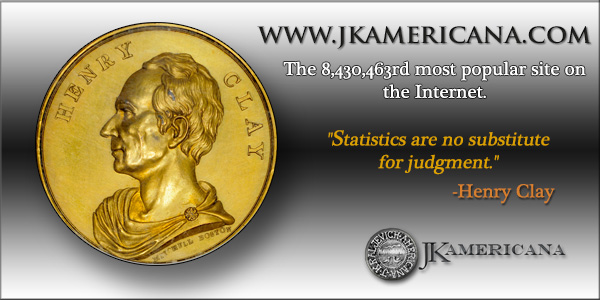
PREV ARTICLE
NEXT ARTICLE
FULL ISSUE
PREV FULL ISSUE
COINS AT CHRISTMAS - A COIN COLLECTOR’S CHRISTMASDavid Pickup submitted this holiday article about coins and Christmas. Thanks! -Editor
Coins at Christmas - A Coin Collector’s Christmas
We will start not at the beginning of Christmas but at another beginning. Less important than the nativity, but of great importance to collectors. A few days before Christmas in 1836, on 22nd December, a number of "friends of numismatic science" met in London to set up the Numismatic Society. Their purpose was to "exhibit rare and curious specimens of numismatic art of all ages and countries" as well as read papers on numismatic subjects. I imagine they liked to chat about the "good old days" as well as coins collectors sometimes do. Membership cost a guinea and a council of seven men were appointed which included William Wyon and Edward Hawkins. John Yonge Akerman and Isaac Cullimore were the first secretaries. Akerman started the society’s journal in the same year. Hawkins was keeper of antiquities at the British Museum and wrote the book called Medallic Illustrations. Akerman was the author of many popular and more specialised books on coins. This was the first meeting of what became the Royal Numismatic Society and the first society devoted to numismatics anywhere.
Dickens is said to have invented our modern idea of Christmas with its snow, frost and cold. The 1830s were amongst the coldest on record. Snow lasted well into March, with 8 or 9 feet of snow being reported in parts of the country. This continued for a number of winters. On Christmas Day 1836, the roads were impassable with snow lying five to fifteen deep in many places, and drifts of over twenty feet. Let us leave the "friends of numismatics" to the snow and cold and think about other Christmas coins.
Christmas is a time for presents of course. Chocolate coins are traditionally given to children as both a Christian and secular tradition at Christmas time and Saint Nicholas Day and in Jewish tradition during Hanukkah. Adult coin collectors are allowed chocolate coins as well in fact it is a good way of combining an interest in numismatics with food. They tend to study the foil wrapper closely to look for mint errors, brockages, and rare dates before eating them. In 2011 The British Daily Mail reported that shops were stopping selling Euro chocolate coins and going back to Sterling chocolate coins. Another tradition which I can remember, so it is later than the Middle Ages, is putting silver coins in Christmas puddings. You had to be careful not to break a tooth when you bit into the pudding. Perhaps it was a way of getting children to eat slowly. Good luck with that! Not many numismatists seem to get numismatic presents even at this time of year. Why not buy yourself something as a treat? However you are celebrating have a brilliant Christmas and an uncirculated New Year.  Wayne Homren, Editor The Numismatic Bibliomania Society is a non-profit organization promoting numismatic literature. See our web site at coinbooks.org. To submit items for publication in The E-Sylum, write to the Editor at this address: whomren@gmail.com To subscribe go to: https://my.binhost.com/lists/listinfo/esylum All Rights Reserved. NBS Home Page Contact the NBS webmaster 
|

